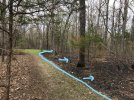Early Bird
5 year old buck +
I am in the process of cutting 1/2-2/3 acre bedding area on the property. Mostly comprised of Poplar, Red Maple and a few oaks. I will be doing mostly clear cutting but will be leaving the highest potential oak trees and perhaps hinging a few of the smaller red maples. The area is a south facing bench and slope so it will get a great deal of sun. The area has a lot of leaves covering the ground and I was wondering if there is a benefit to blowing the leaves out of the cut area (within reason) so it will kick start the regeneration. Thoughts?
Thanks,
Ray
Thanks,
Ray
